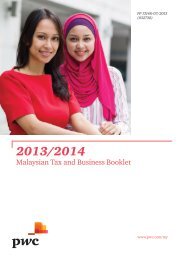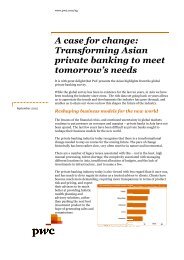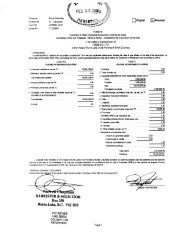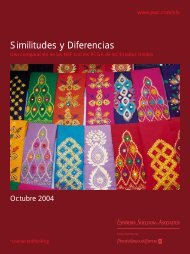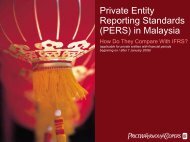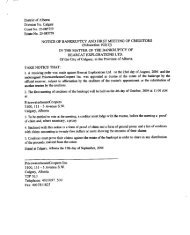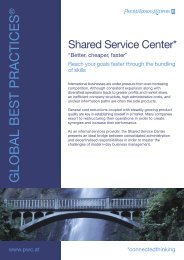TLS Newsletter 11 marzo 2011 - PwC
TLS Newsletter 11 marzo 2011 - PwC
TLS Newsletter 11 marzo 2011 - PwC
Create successful ePaper yourself
Turn your PDF publications into a flip-book with our unique Google optimized e-Paper software.
La detassazione dei premi<br />
di produzione<br />
(Nicla Cimmino- Carmen Ettorre)<br />
Il regime di tassazione sostitutiva dei premi di produttività<br />
erogati ai dipendenti privati è stato introdotto, per il<br />
periodo dall’1 luglio 2008, dall’articolo 2, D.L. 93/2008,<br />
convertito dalla Legge n. 126/2008 e poi prorogato,<br />
con alcune modifiche, per il 2009, dall’articolo 5, DL<br />
n. 185/2008, convertito dalla Legge n. 2/2009, e per il<br />
2010, dall’articolo 2 Legge n.191/2009.<br />
Per quanto riguarda il 2008, la Legge, prevedeva l’applicabilità<br />
dell’imposta sostitutiva a condizione che:<br />
- i compensi fossero erogati per lavoro straordinario,<br />
lavoro supplementare, lavoro reso sulla base di clausole<br />
elastiche oppure in relazione ad incrementi di produttività;<br />
- le somme fossero a favore dei titolari di un reddito di lavoro<br />
dipendente non superiore, nel 2007 ad euro 30.000<br />
- la somma erogata non fosse superiore ad euro 3.000.<br />
Per gli anni 2009 e 2010, le nuove disposizioni normative<br />
hanno, di fatto, prorogato l’agevolazione inserendo<br />
alcune modifiche:<br />
- è stato ridotto il novero degli emolumenti agevolabili,<br />
limitando l’applicabilità della tassazione agevolata alle<br />
somme erogate in relazione ad incrementi di produttività;<br />
- è stato innalzato a 35.000 euro (che diventano 40.000<br />
nel 20<strong>11</strong>) il limite del reddito da lavoro dipendente,<br />
relativo all’anno precedente, cui è subordinato l’accesso<br />
al beneficio;<br />
- è stato innalzato a 6.000 euro l’importo massimo delle<br />
somme agevolabili.<br />
Con la Risoluzione 17 agosto 2010 n. 23, e le successive<br />
Circolari (n.47 e n.48 del 27 settembre 2010) l’Agenzia<br />
delle Entrate ha definito ulteriormente l’ambito<br />
oggettivo di applicazione della normativa in materia di<br />
detassazione dei premi di produttività, soffermandosi<br />
sui compensi erogati per lavoro organizzato sulla base di<br />
turni, lavoro notturno e lavoro straordinario.<br />
Gli stessi provvedimenti hanno previsto una specifica<br />
procedura per consentire ai lavoratori il recupero delle<br />
maggiori imposte versate, nel 2008 e nel 2009, sulle<br />
somme percepite in tali anni che, pur avendo i requisiti<br />
per essere tassate con imposta sostitutiva del 10%, siano<br />
state assoggettate dal sostituto di imposta a tassazione<br />
ordinaria.<br />
In ultima istanza, sono stati forniti chiarimenti circa il regime<br />
fiscale applicabile alla quota di contributi restituita<br />
al lavoratore a seguito dell’ammissione dell’azienda allo<br />
sgravio contributivo sui premi di risultato previsto dalla<br />
Legge n. 247/2007.<br />
Tax relief on productivity bonuses<br />
(Nicla Cimmino – Carmen Ettorre)<br />
The substitute tax regime of productivity bonuses paid to<br />
employed workers in the private sector, was introduced<br />
for the second half of 2008 by article 2 of Decree law no.<br />
93/2008 (converted into Law no.126/2008), this benefit<br />
was extended, with some changes, for 2009 by article 5 of<br />
Decree Law 185/2008 (converted into Law 2/2009), and<br />
for 2010 by article 2 of Decree Law 191/2009.<br />
In 2008, the Law provided the application of the tax relief<br />
under the following conditions:<br />
- the fees were paid out for overtime work, supplementary<br />
work and work rendered according to flexibility clauses, as<br />
well as for the amounts paid out in relation to increases in<br />
productivity;<br />
- the income limit paid to an employee didn’t exceed the<br />
sum of Euro 30.000 in 2007;<br />
- the limit of the amounts subject to tax relief didn’t exceed<br />
Euro 3.000.<br />
Instead, for 2009 and 2010, the new regulations were<br />
extended but a considerably number of changes were introduced:<br />
- the reduction of the fees facilitating range, by limiting<br />
the applicability of the preferential taxation on the amount<br />
paid in relation to productivity gains;<br />
- the income limit, to which entitlement to tax relief is<br />
subject, was raised to Euro 35.000 (Euro 40.000 in 20<strong>11</strong>).<br />
- the limit of the amounts subject to tax relief was raised to<br />
Euro 6.000<br />
With Res. 17/08/2010 No. 23 and the subsequent Circular<br />
(No. 47 and 48 of 09.27.2010), the Revenue Agency has<br />
further defined the scope of application of objective rules<br />
regarding the tax relief on productivity bonuses, focusing<br />
on compensation paid for organized labor on the basis of<br />
shifts, night work and overtime.<br />
The same practice has provided a procedure that allows<br />
workers to recover the higher taxes paid in 2008 and 2009,<br />
on the amounts received in those years that, even though<br />
they met the requirements to be taxed at 10% with substitute<br />
tax, but in fact were subject to the ordinary taxation.<br />
Ultimately, they have provided some clarification regarding<br />
the tax regime applicable to the amount of contributions<br />
that should be returned to the worker after the admission<br />
of the employer of the tax relief regarding the performance<br />
bonuses as established by the Law 247/2007.<br />
25 <strong>TLS</strong> <strong>Newsletter</strong> n° 3 Anno 20<strong>11</strong>




